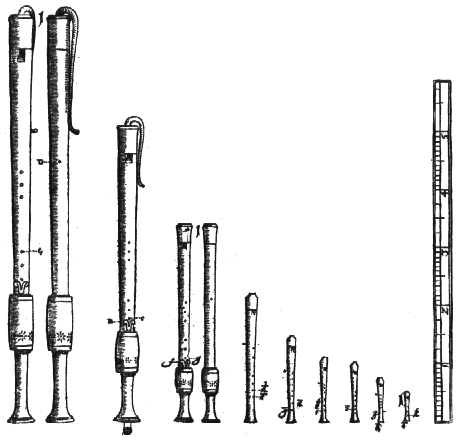Great bass recorder on:
[Wikipedia]
[Google]
[Amazon]
 The great bass recorder is a member of the
The great bass recorder is a member of the
 The great bass recorder is a member of the
The great bass recorder is a member of the recorder
Recorder or The Recorder may refer to:
Newspapers
* ''Indianapolis Recorder'', a weekly newspaper
* ''The Recorder'' (Massachusetts newspaper), a daily newspaper published in Greenfield, Massachusetts, US
* ''The Recorder'' (Port Pirie), a news ...
family. With the revival of the recorder by Arnold Dolmetsch, who chose Baroque music and the corresponding recorder types as a fixed point, consideration was given to the design of recorder types larger than the bass recorder. The great bass recorder has up to seven keys, which serve to facilitate access to the finger holes. For modern large bass recorders woods like maple or African Bubinga
''Guibourtia'' is a flowering plant genus in the family Fabaceae, also known by the common names as Rhodesian copalwood, African Rosewood, Amazique, Bubinga, Kevazingo, and Ovangkol. Scientific Name being Guibourtia spp.
Description
''Guibou ...
are used. The term usually applies to an instrument with range is c–d2 (g2), but has also been used to describe an instrument descending to B or else to the low bass recorder in F, alternatively known as a contrabass. When "great bass" is used for the instrument in low F, the instruments in C and B are referred to as "quart-bass" and "quint-bass", respectively, because they are a fourth and fifth below the ordinary small bass, or "basset". The prefixes "great" and "contra" refer to the registers from C to B and from ͵C to ͵B, respectively, in Helmholtz pitch notation
Helmholtz pitch notation is a system for naming musical notes of the Western chromatic scale. Fully described and normalized by the German scientist Hermann von Helmholtz, it uses a combination of upper and lower case letters (A to G), and the s ...
.
History
In theGermanisches Nationalmuseum
The Germanisches National Museum is a museum in Nuremberg, Germany. Founded in 1852, it houses a large collection of items relating to German culture and art extending from prehistoric times through to the present day. The Germanisches National ...
in Nuremberg
Nuremberg ( ; german: link=no, Nürnberg ; in the local East Franconian dialect: ''Nämberch'' ) is the second-largest city of the German state of Bavaria after its capital Munich, and its 518,370 (2019) inhabitants make it the 14th-largest ...
are two famous great bass recorders. Both are of the Renaissance type, despite the fact that the instrument of (1636–1686) is provided on the head piece with high baroque ornaments. This recorder is part of an ensemble set that is made of plum wood. For larger recorders pear wood is usually used, for reasons of cost.
The great bass recorder requires a key for the bottom note, which was protected by a so-called fontanelle. An S-shaped bocal or crook
Crook is another name for criminal.
Crook or Crooks may also refer to:
Places
* Crook, County Durham, England, a town
* Crook, Cumbria, England, village and civil parish
* Crook Hill, Derbyshire, England
* Crook, Colorado, United States, a ...
is used to make it somewhat more comfortable to play the instrument.
Because the finger holes are not covered with keys, some of the tone holes are placed in acoustically unfavorable locations to accommodate the hand. The relatively large finger-span distance reduces fluency of playing.
As an authentic instrument, the great bass recorder has a short history of about 100 to 120 years. The instrument is only described in the Syntagma Musicum
''Syntagma Musicum (1614-1620)'' is a musical treatise in three volumes by the German composer, organist, and music theorist Michael Praetorius. It was published in Wittenberg and Wolfenbüttel. It is one of the most commonly used research source ...
of Michael Praetorius
Michael Praetorius (probably 28 September 1571 – 15 February 1621) was a German composer, organist, and music theorist. He was one of the most versatile composers of his age, being particularly significant in the development of musical forms ba ...
(1619) and Marin Mersenne (''L'Harmonie Universelle'', Paris 1637). The earliest great bass recorder is probably that in the collection of Venetian Catajo Palace. It is now in the Kunsthistorisches Museum in Vienna. The great bass recorder is given the name "''Bass''Flöt" (bass recorder) by Michael Praetorius, and described by him as an instrument in B, a perfect fifth lower than the basset, or "small" bass in F.
Marin Mersenne describes a great bass recorder with a very delicate carved double key for the lowest tone and the overlying semitone. The problem of the minor second above the bass tone, which can be achieved only by half-holing and which not every recorder player can get used to, is not solved by Mersenne's innovation by analogy to other instruments.
The Kynseker instrument from the Germanisches Nationalmuseum is both the highpoint and the endpoint of development. It lags behind Mersenne's ideas. It is possible that it was already conceived as historicizing.
References
Further reading
* * * * {{Authority control Baroque instruments Early musical instruments Internal fipple flutes Recorders (musical instruments)